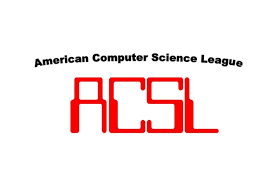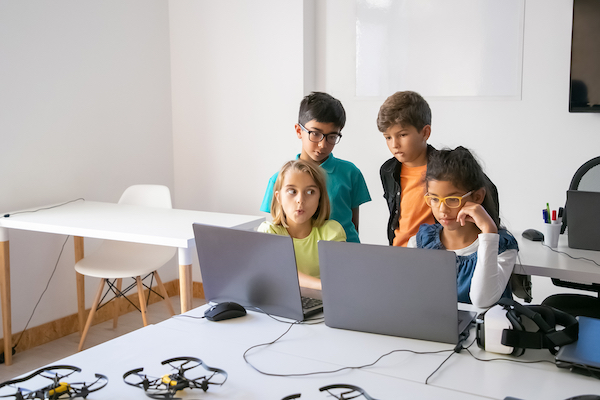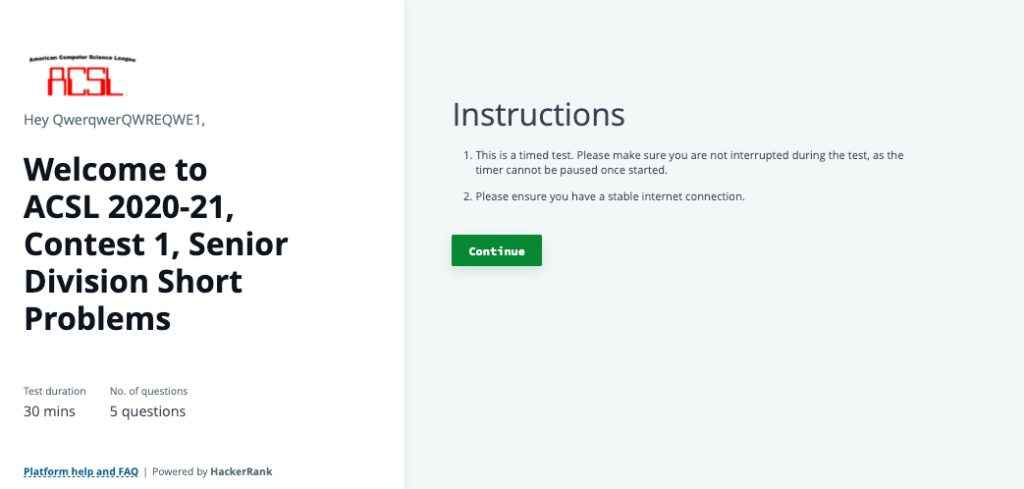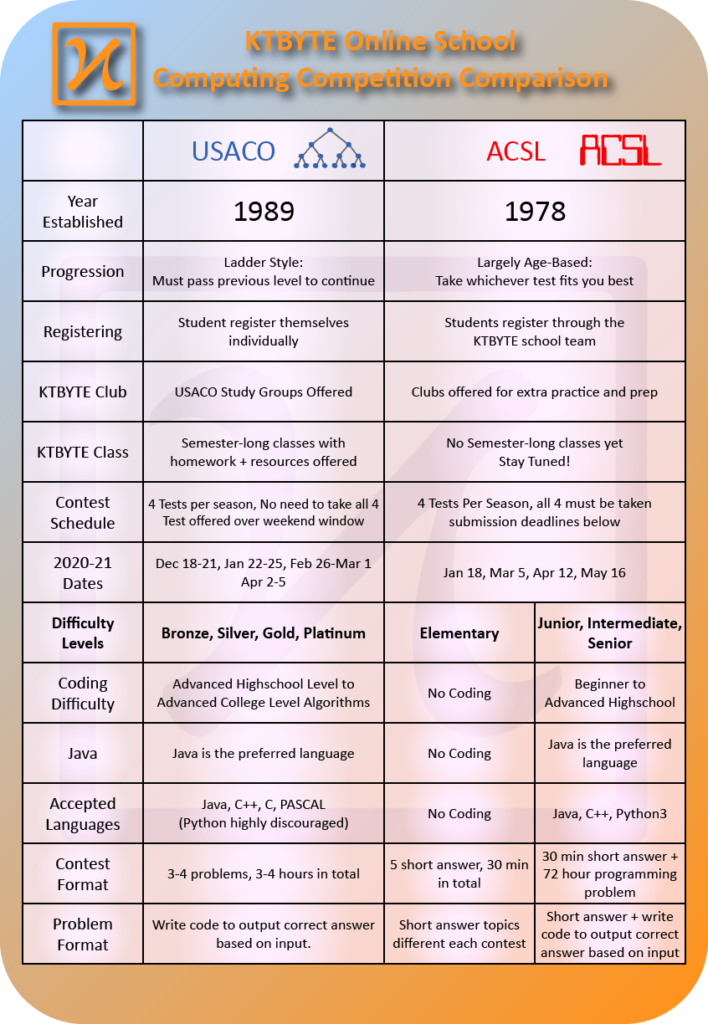Table of Contents
- What is the American Computer Science League?
- How should my child choose which division to be a part of?
- What does an ACSL contest look like?
- What is HackerRank?
- How long do students have to complete each contest?
- How can my child find an ACSL team to join?
- Do ACSL team members have to live in the United States?
- What should my child expect as part of the KTBYTE team?
- What are the best ways for students to prepare for ACSL contests?
- How can KTBYTE students prepare for ACSL contests?
- About our Prep Club offerings
- About our Study Materials offerings
- Who can join the KTBYTE team and prep offerings?
- How does ACSL compare to other CS competitions?
- How can my child become a KTBYTE ACSL Instructor or Teaching Assistant?
1. What is the American Computer Science League?
American Computer Science League (ACSL) organizes team computer programming and computer science contests for K-12 schools, organizations and local groups.
https://www.acsl.org/about
The ACSL differs from many other STEM competitions in that all participants must compete as part of a team. Contestants receive invitations through their team to four contests throughout the school year: this year’s contests (2021-2022) are released on November 1, December 27, January 31, and March 7.
ACSL is very well-established among computing competitions and as of Fall 2021 is entering its 44th year of continuous operation! This gives the competition a certain level of prestige for things like college applications
2. How should my child choose which division to be a part of?
ACSL has five divisions: Senior, Intermediate, Junior, Classroom, and Elementary, providing an appropriate challenge for students of varying ages and abilities. We encourage schools and organizations to join more than one division, so that each student can participate in the division best matching their ability.
https://www.acsl.org/get-started/divisions
KTBYTE supports teams in all of these divisions other than Classroom. The guidelines for choosing a division are as follows:
- Elementary: Open to students in grades 3-6 (aged 8-12 years old)
- Junior: Open to students in grades 9 and below (ages 15 and younger). This division is suitable for middle and ealry high school students with no previous programming experience.
- Intermediate: This division is intended for high school students with little or no programming experience, or advanced middle school students.
- Senior: This division is intended for advanced high school students.
Most advising organizations (including KTBYTE) can help families choose a team if they are unsure of where to start. Interested students can also gauge what division to join by trying some sample contests.
3. What does an ACSL contest look like?
Most ACSL contests have two parts: a short answer section and a programming section. The exception to this is Elementary Division contests, none of which contain a programming section. Although every ACSL participant is part of a team, students take the contests individually and are not allowed to collaborate with their teammates.
Short Answer Problems: Each short answer section consists of 5 multiple choice problems. Topics are announced for each contest and draw from a variety of computational thinking topics. For instance, Contest 1 includes questions on Computer Number Systems, Recursive Functions, and analyzing a sample program that involves Branching.
Programming Problems: These questions all require participants to submit a piece of code to solve some problem. All of these require taking some input data and generating an output based on the problem description. For this reason it’s important for contestants in all divisions besides Elementary to get some practice working with data in order to practice these problems.
What is HackerRank?
HackerRank is an online programming environment that the American Computer Science League uses to administer the contests. This platform has a lot of features, and students are encouraged to familiarize themselves before attempting a contest by clicking the Try Sample Test button on the initial page.
4. How long do students have to complete each contest?
Unlike some other computing competitions ACSL gives students a long window during which they can choose to attempt each contest. For example, this year Contest 1 was released on November 1 and teams have until January 16 to complete it.
However, this does not mean that students can continue working on the contest for the entire time it is available. Once a contestant begins working on a short answer section they only have 30 minutes to complete all 5 problems. The programming section is more lenient, giving students 72 hours to submit their work once they first view the problem.
This format of schedule alone may be a reason for students to choose the ACSL over other competitions. Rather than having to fit the rest of their schedule around these contests, students can choose when to attempt each short answer and programming section.
5. How can my child find an ACSL team to join?
ACSL teams may be organized by traditional K-12 schools or by other youth organizations. KTBYTE hosts teams each year for the Elementary, Junior, Intermediate, and Senior divisions. Students from around the world are welcome to join our ACSL teams, whether or not their school already has one.
Do ACSL Competitors need to be living in the United States?
Many international families may have this concern, due to the name American Computer Science League and the fact that until recently ACSL contests were administered in person. As of the 2020-2021 season, ACSL contests were hosted exclusively online. This opened up the possibility for aspriring programmers around the world to take part in this competition for the first time! Currently students in any part of the world can take part in the ACSL, including as part of a team hosted by a US organization.
What should my child expect as part of the KTBYTE team?
Registration on the KTBYTE ACSL team is free for current students and costs $50 for non-students. While we can’t provide a physical space for teams to meet, we encourage members to collaborate via our email threads and Facebook groups. We are excited to support our ACSL families through information sessions and seminars throughout the contest season.
6. What are the best ways for students to prepare for ACSL contests?
The American Computer Science League offers free study materials for all divisions, including a helpful Wiki for understanding the different problem types. Although students compete in the contests individually, we encourage teams to prepare together and share techniques for tackling each type of problem. Read on to discover how KTBYTE students can choose to gain extra study resources from any of several options!
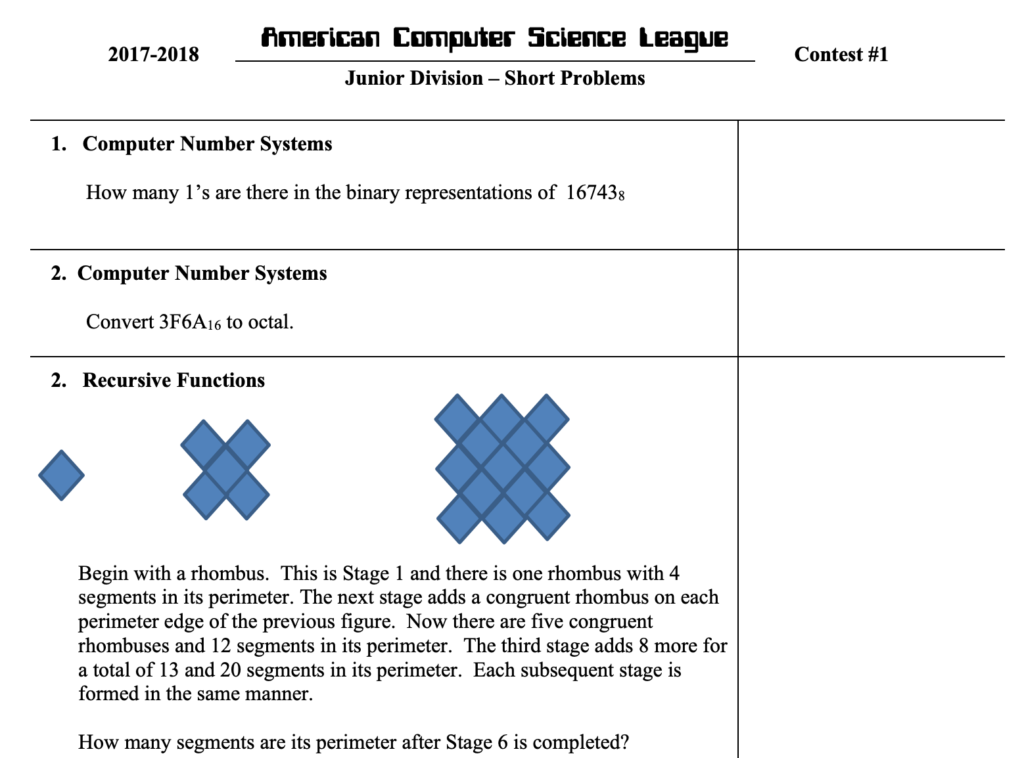
7. How can KTBYTE students prepare for ACSL contests?
All KTBYTE parents are encouraged to attend our Parent Education Seminars and ACSL Information Sessions to further their understanding of the competition. If we don’t have an event planned in the near future we’d be happy to schedule a call or share recordings from past sessions. Please email info@staff.ktbyte.com with your request.
About our Prep Club offerings
For students who benefit from a more structured learning environment we also teach online prep clubs throughout the ACSL contest season. These are taught by qualified instructors at 3 levels of difficulty: Elementary, Junior, and Intermediate/ Senior.
About our Study Materials offerings
The Study Materials offering was added this year as a way for students to gain extra resources without being part of a prep club. Everyone who enrolls in either Elementary/ Junior or Intermediate/ Senior Study Materials will gain access to the prep club class page, including all of the former contest problems that prep clubs use to prepare. This offering is unique to KTBYTE in that students are never required to attend class; instead they can choose to join Student Help Hours to meet with a Teaching Assistant. All of our ACSL Teaching Assistants have competed in the contest and can assist students with practice problems and study techniques.
8. Who can join the KTBYTE team and prep offerings?
The KTBYTE ACSL team is open to anyone who wants to join, provided they are not registered on a different ACSL team. After joining the team, a student can choose how much or little they want to interact with their teammates. It’s also up to them whether they want to take any of our additional prep offerings.
Our Prep Clubs and Study Materials are available for any member of the KTBYTE ACSL team to enroll in. Unfortunately, we cannot allow students from other teams to join our prep offerings, as the ACSL restricts us to sharing these resources only with members of the KTBYTE team.
9. How does ACSL compare to other CS competitions?
The ACSL is widely considered to be one of the most accessible computer science competitions for beginners. Other prestigious competitions like the USA Computing Olympiad (USACO) and Canadian Computing Competition (CCC) require even first-time competitors to be able to program at an intermediate level. You can find a side-by-side comparison of some aspects of USACO and ACSL in the graphic below.
In fact, the ACSL stands alone among these competitions in that students can start preparing without any prior coding experience. This is especially true for students in the ACSL Elementary Division, where there is no programming problem. However, even students at the Junior level may be able to gain enough coding skills while preparing for the contest to do well. This is especially true for students who complement their contest prep with an introductory coding class, like KTBYTE’s Fun3a.
By comparison, the USACO Bronze Division (where all participants start) requires a fairly advanced knowledge of data structures and beginner algorithms in order to do well. For this reason, most students wait to start trying the USACO until they have completed at least one advanced course, like KTBYTE’s CS01b.
If you have questions about how the ACSL compares to other computer science competitions we encourage you to reach out to info@staff.ktbyte.com and our staff will get back to you as soon as possible.
10. How can my child become a KTBYTE ACSL Instructor or Teaching Assistant?
The KTBYTE community is proud to support our students who choose to mentor their peers while gaining experience in the field of CS education. All of our ACSL Instructors and Teaching Assistants (TAs) are former or current participants in the ACSL. In fact, our Elemenatry/ Junior Division TA is currently a member of our Senior Division team!
In general we require TAs to be at least age 14 and Instructors to be age 16 or older, depending on the position. That said, all students regardless of age are welcome to reach out about these opportunities so we can help them work towards their goals. Some of our best Instructors are former students who chose to become Teaching Assistants while still taking our advanced courses. Anyone who is interested in either of these roles is encouraged to email their resumé and cover letter to info@staff.ktbyte.com.
